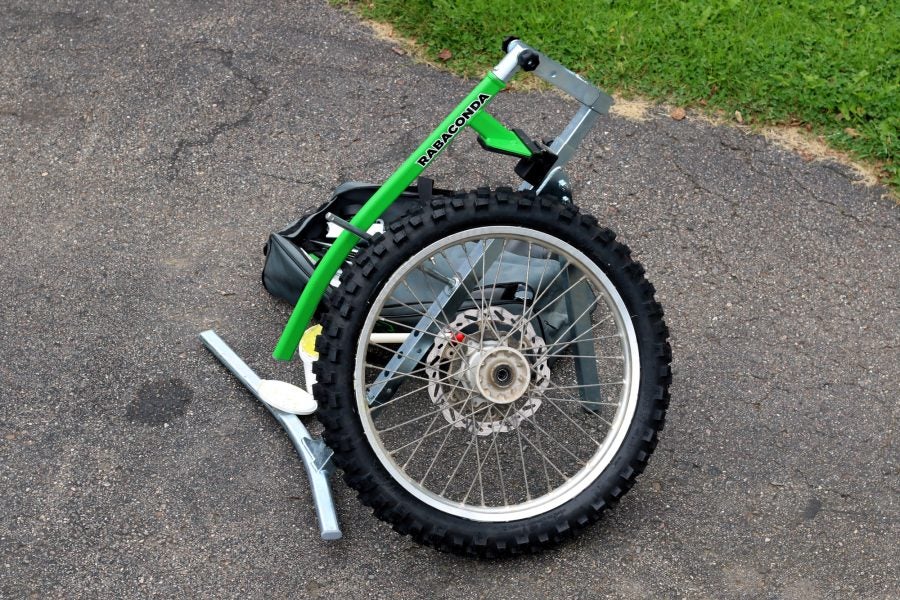Every motorcyclist has to change their bike’s tires eventually, and it can be a massive pain in the neck arranging a visit to the dealership to get it done. Many of us do our own changes to save money and avoid that hassle. That job isn’t particularly complicated on a trail bike with tubed dual sport tires; it gets harder when you deal with street tires that have a stiff carcass. Also, it’s easy to scratch your rim while messing about with tire levers. Surely there’s a way to make the DIY tire change easier, without springing for a full hydraulic machine?
This is exactly what Rabaconda offers with its Street Tire Changer. They shipped me one this year, and I have been messing around with it since the spring. Here my observations at this point:
It’s a lot easier if you read the instructions(and then watch the video)
If you’ve changed a few tires before, especially if you’re experienced with a tire-changer machine, you can probably figure out how the Rabaconda works. Still, the instructions will clarify some points that would confuse you after setting it up. Read the included booklet, and then watch the video to get a good overview of the tire-changing process. I’ll embed Rabaconda’s video below so you can see exactly how they recommend you use the machine. Basically, it consists of an angled stand and a handle that you first mount atop the stand to break the bed. Then, you mount the handle to a ratcheting mechanism in the middle, where it moves a “duck’s head” to either mount or dismount the tire bead on the rim.
Slower setup, quicker procedure
I’ve changed lots of dual sport tires by hand, and it usually goes something like this: You grab the tire irons and some other odds and ends, which takes about two minutes. Then you have to break the tire’s bead, dismount the old tire, mount the new tire and then set the new bead. When I’m doing the job by hand, this is the part that takes the time.
With the Rabaconda, the mechanics of actually breaking the bead, dismounting the tire, etc., are the fast part. Most of your time is spent assembling the machine, making sure it’s fitted correctly to your rim. Once you’re cranking the handle on the machine, everything goes pretty quickly. This is especially true of the last part of the job, where so many riders end up poking a hole in their tire tube as they try to muscle the final inches of the bead onto the rim.
Also note that although the actual bead-breaking and tire-mounting actions are fairly simple, you do have to use levers at various points of the procedures. If you’re not paying attention here, they can slip loose and scratch your rim. Suffice it to say that just like any other tire changer, the Rabaconda does come with a learning curve—just like tire irons themselves and any other tool.
It’s a universal machine, but it won’t work well for every tire or rim
On my Bandit 1200S, the front tire was easily dismounted, but the Rabaconda wouldn’t break the bead on the rear tire. FWIW, when I took that wheel to my friend’s garage, his pneumatic machine struggled with it too—I’m not faulting the Rabaconda here.
Also, this is designed as a tire changer for street bikes. From my usage, I’d say wheels in the 16-19 inch range will fit it best, and 21-inch fronts from big ADV bikes should be OK. However, the rim on my WR250R 21-inch front was too narrow to fit the machine properly. I suspect that the dirt bike version of this tire changer would have no issues with the WR250R rim.
Rabaconda does note that its tire changer will need an adapter to fit some hubs, such as BMW GS models.

Note all the stuff that comes with the starter kit. Those clamps on the left are used to keep the tire in the rim’s drop center while you’re mounting it. The kit also comes with tire lube and levers. Everything fits very nicely into that zippered bag, making for easy storage. Photo: Rabaconda
It doesn’t eat up shop space
Most tire changers, even the simple ones, take up a big chunk of space in your shop. The Rabaconda system packs into roughly the same space as a large tent, and can be thrown into the back of a cupboard or shelf. If you’re doing track days or rallies or otherwise need to be mechanically mobile, the Rabaconda easily fits into the back of your truck or trailer.
The forum’s response
A few inmates have their own Rabacondas and have posted up their experiences here and here.
The final word
At $600ish for the Starter Kit, the Rabaconda tire changing system is a significant investment. However, if you’re frequently changing tires on a big-bore bike, it wouldn’t take long to save that money. The Rabaconda system also allows you to break away from relying on dealership staff to change your tires, which can be inconvenient. If you’re worried about scratched rims, which can also happen in a dealer’s shop, the Rabaconda allows you do the work under your own watchful eye.
But obviously, if you’re the type of rider who owns a DR650 or KLR650 or other lower-priced Japanese dual sport or older ADV, you’re facing diminishing returns here. With all that in mind, I think the Rabaconda tire changing system is a good investment for many riders, but if you rarely change tires or you’re riding an older bike with beat-up rims, you’re less likely to see the financial benefit of the investment. No surprise there, that’s true of all tools!







